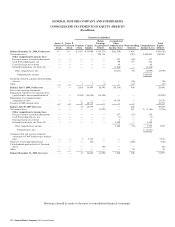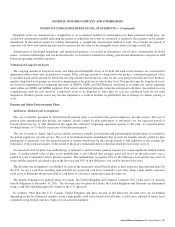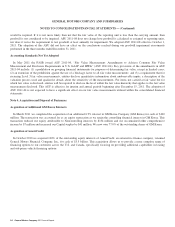General Motors 2011 Annual Report Download - page 90
Download and view the complete annual report
Please find page 90 of the 2011 General Motors annual report below. You can navigate through the pages in the report by either clicking on the pages listed below, or by using the keyword search tool below to find specific information within the annual report.GENERAL MOTORS COMPANY AND SUBSIDIARIES
NOTES TO CONSOLIDATED FINANCIAL STATEMENTS — (Continued)
In the U.S., Old GM established a discount rate assumption to reflect the yield of a hypothetical portfolio of high quality, fixed-
income debt instruments that would produce cash flows sufficient in timing and amount to satisfy projected future benefits.
Plan Asset Valuation
Cash Equivalents and Other Short-Term Investments
Money market funds and other similar short-term investment funds are valued using the net asset value per share (NAV) as
provided by the investment sponsor or third party administrator. Prices for short-term debt securities are received from independent
pricing services or from dealers who make markets in such securities. Independent pricing services utilize matrix pricing which
considers readily available inputs such as the yield or price of bonds of comparable quality, coupon, maturity and type as well as
dealer supplied prices. Money market mutual funds which provide investors with the ability to redeem their interests on a daily basis
and for which NAVs are publicly available are classified in Level 1. Other cash equivalents and short-term investments are classified
in Level 2.
Group Annuity Contracts
Group annuity contracts are the contracts entered into with a life insurance company, which are used as a funding instrument for
specified benefits payments to be made in accordance with the defined benefit pension plans. The contracts may be backed by one or
more separately managed investment accounts, which generally hold investments in high quality fixed income securities. The fair
value of each contract depends, to a significant extent, on the values of the units of the separately managed investment accounts
backing the contract. The fair value of the separately managed investment account assets is based on the fair value of the underlying
securities held which are determined by each of the insurance companies. From time to time, the defined benefit pension plans’
liabilities may increase when certain contractually required reserves, as estimated by an insurer under the terms of the contract, exceed
the fair value of contract assets. The resulting difference represents an outstanding contract asset deficiency that must be funded by
the defined benefit pension plan’s sponsor. Group annuity contracts are unallocated arrangements and are classified in Level 3.
Common and Preferred Stock
Common and preferred stock securities for which market prices are readily available by the Company at the measurement date, are
valued at the last reported sale price or official closing price on the primary market or exchange on which they are actively traded and
are classified in Level 1. Such equity securities for which the market is not considered to be active are valued via the use of
observable inputs, which may include, among others, the use of adjusted market prices last available, bids or last available sales prices
and/or other observable inputs and are classified in Level 2. Common and preferred stock classified in Level 3 are those privately
issued securities or other issues that are valued via the use of valuation models using significant unobservable inputs that generally
consider among others, aged (stale) pricing, earnings multiples, discounted cash flows and/or other qualitative and quantitative
factors. We may consider other security attributes such as liquidity and market activity in assessing the observability of inputs used by
pricing services or dealers, which may affect classification in the fair value hierarchy.
Government, Agency and Corporate Debt Securities
U.S. government and government agency obligations, foreign government and government agency obligations, municipal
securities, supranational obligations, corporate bonds, bank notes, floating rate notes, and preferred securities are valued based on
quotations received from independent pricing services or from dealers who make markets in such securities. Debt securities which are
priced via the use of pricing services that utilize matrix pricing which considers readily observable inputs such as the yield or price of
bonds of comparable quality, coupon, maturity and type as well as dealer supplied prices, are classified in Level 2. Securities within
this category that are typically priced by dealers and pricing services via the use of proprietary pricing models which incorporate
significant unobservable inputs are classified in Level 3. These inputs primarily consist of yield and credit spread assumptions. We
may consider other security attributes such as liquidity, market activity, price level, credit ratings and geo-political risk in assessing
the observability of inputs used by pricing services or dealers, which may affect classification.
88 General Motors Company 2011 Annual Report
























